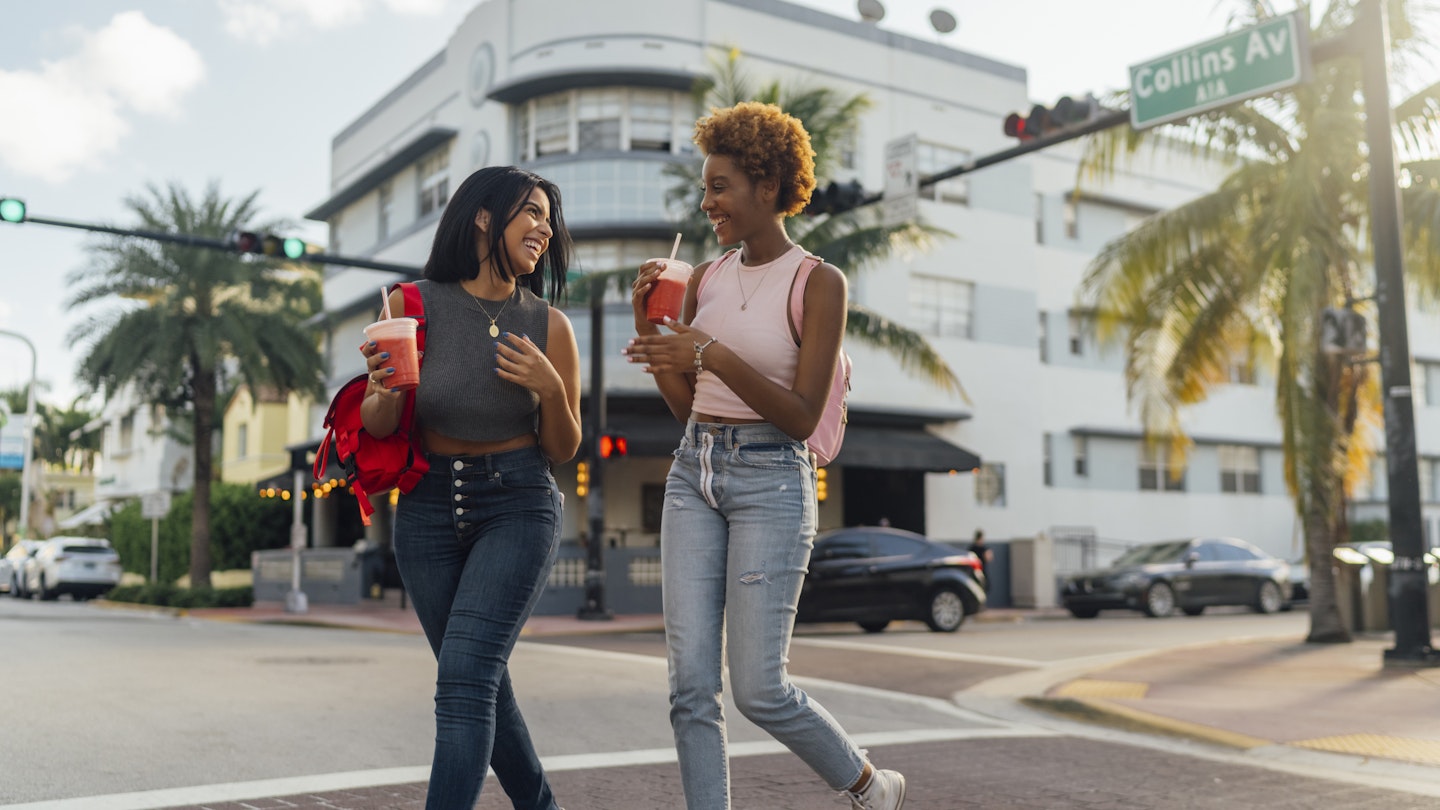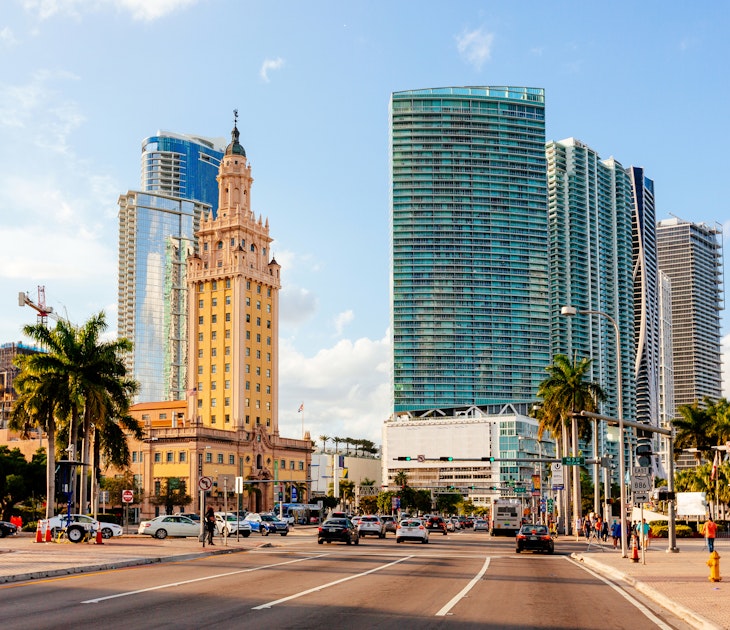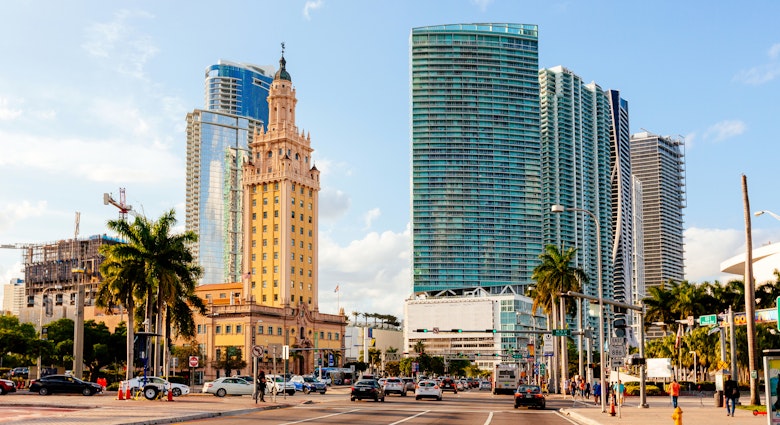Miami’s major sights aren’t concentrated in one neighborhood, so any trip to the city will involve jumping from one district to another. Fortunately, it's easy to explore, whether you rely on buses and trains, ride the trolley or get around by car.
The most frequently visited area is South Beach – the hub for Miami's hottest nightlife, most beautiful beaches and most iconic art deco hotels – but you’ll find historic sites and museums in the Downtown area, street art in Wynwood, galleries in the Design District, old-fashioned hotels and eateries in Mid-Beach (in Miami Beach), more beaches on Key Biscayne, and peaceful neighborhood attractions in Coral Gables and Coconut Grove.
Connecting it all are fast highways, buses, trolleys and trains. Give some thought to hiring a car – it's the easiest way to reach many parts of the city, and you can offset the cost by taking advantage of the many free things to do in Miami.
Whether you're coming for the blinding heat of summer or the winter sun, here's our guide to getting around Florida's Magic City.
Arriving in Miami
The majority of travelers come to Miami by air, although it's feasible to arrive by car, bus or even train. Miami is a major international airline hub, with flights to many cities across the USA, Latin America and Europe. Around 60 airlines fly here; bank on flight times of 3.5 hours from New York City, 5 hours from Los Angeles, and 10 hours from London or Madrid.
Located 6 miles (9.7km) west of Downtown, the busy Miami International has three terminals and serves more than 45 million passengers each year. Getting into town is a breeze. Miami International Airport Taxis charge a flat rate for the 40-minute drive to South Beach ($35). The Miami Beach Airport Express (bus 150) costs $2.25 and stops all along Miami Beach, from 41st to the southern tip. SuperShuttle runs a shared-van service, costing about $22 to South Beach.
You may also find a deal on flights to nearby Fort Lauderdale-Hollywood International Airport (FLL), around 26 miles (42km) north of Downtown Miami. This airport largely serves domestic passengers and is well connected to major hubs like New York and Atlanta. The GO Airport Shuttle runs shared vans to Miami, with prices around $25 to South Beach. A taxi costs about $75 (metered fare) to South Beach and $65 to Downtown.
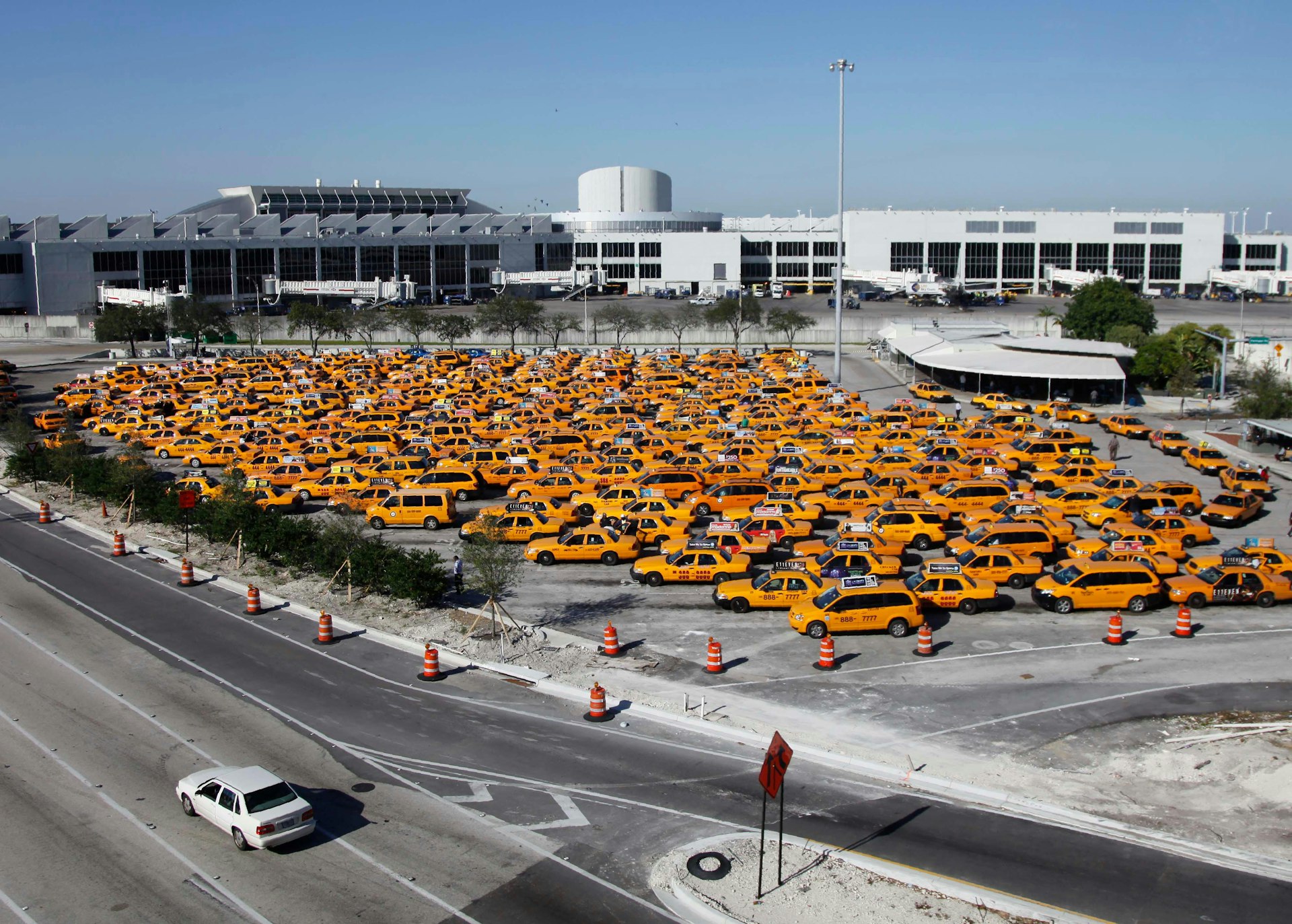
Getting to Miami by train
The main Miami terminal of Amtrak is about 9 miles (14.5km) northwest of Downtown, connecting the city with several other points in Florida (including Orlando and Jacksonville) on the Silver Service line that runs up to New York City. Travel time between New York and Miami is 27 to 31 hours. The Miami Amtrak station is connected by Tri-rail trains to Downtown Miami.
The new MiamiCentral development, located Downtown, includes the station for privately-run Brightline trains, which run to West Palm Beach and will soon connect to Orlando.
Getting to Miami by boat
Though it’s doubtful you’ll be catching a steamer to make a trans-Atlantic journey, it is quite possible that you’ll arrive in Miami on a cruise ship. The Port of Miami, which receives around five million passengers each year, is known as the cruise capital of the world, and arriving in the port will put you on the edge of Downtown Miami. Taxis and public buses to other local points are available from nearby Biscayne Blvd.

Navigating Miami by car or motorcycle
It's useful to have a car or motorcycle if you want to explore beyond South Beach and Downtown, particularly for visiting places like Coral Gables and North Miami Beach, but there are a few things to be aware of.
Miami Beach is linked to the mainland by four causeways built over Biscayne Bay, from south to north: the MacArthur (the extension of US Hwy 41 and Hwy A1A); Venetian ($3 toll); Julia Tuttle and John F Kennedy. The Rickenbacker Causeway crosses to Key Biscayne for a $3 toll.
The tolls for these roads are automated, so ask about options to include tolls on the Sunpass scheme in the rental cost if you're renting a vehicle. You can find great deals on car rental in Miami, with rates starting as low as $20 per day. The usual international hire companies are represented at the airport and downtown.

Understanding Miami's roads
The most important north-south highway is I-95, which ends at US Hwy 1 south of Downtown Miami. You can follow US Hwy 1 all the way to Key West (and indeed north of Miami all the way north to Maine). It’s called Dixie Hwy south of Downtown Miami and Biscayne Blvd north of Downtown Miami.
The Palmetto Expwy (Hwy 826) makes a rough loop around the city and spurs off below SW 40th St to the Don Shula Expwy (Hwy 874, a toll road). Florida’s Turnpike Extension makes the most western outer loop around the city. Hwy A1A, the road that hugs the Atlantic coast along the Florida peninsula, becomes Collins Ave in Miami Beach.
Miami has an annoying convention of giving major roads multiple names. So, for example, Bird Rd is also SW 40th St and Hwy 976. Hwy 826 is the Palmetto Expwy. US 1 is the Dixie Hwy – except in Downtown when it becomes Biscayne Blvd. Hwy 836 is the Dolphin Expwy, while in Miami Beach, 5th St becomes A1A.
Calle Ocho is SW 8th St, as well as the Tamiami Trail, and US 41 (phew), and Hwy 959 is Red Rd, except when it’s SW 57th St. Somehow, this isn’t as confusing as it reads on paper – most signage indicates every name a route may have, but learning these conventions can be frustrating for first-time Miami drivers.
Besides the causeways to Miami Beach, the major east-west roads are SW 8th St; Hwy 112 (also called Airport Expwy); and Hwy 836 (also called Dolphin Expwy), which slices through Downtown Miami and connects with I-395 and the MacArthur Causeway, and which runs west to the Palmetto Expwy and Florida’s Turnpike Extension.
Top tips for driving in Miami
You must pay for parking nearly everywhere, and if you don't, expect no mercy from the parking enforcement gods. You will be quickly towed and have to pay upwards of $200 plus all the associated headaches to retrieve your vehicle.
Most on-street parking is now done by a smartphone app or payment by phone (though there are still a few pay-and-display ticket machines at some locations). There are many municipal parking garages, which are usually the easiest and cheapest option – look for giant blue ‘P’ signs. You’ll find several located along Collins Ave and Washington Ave.
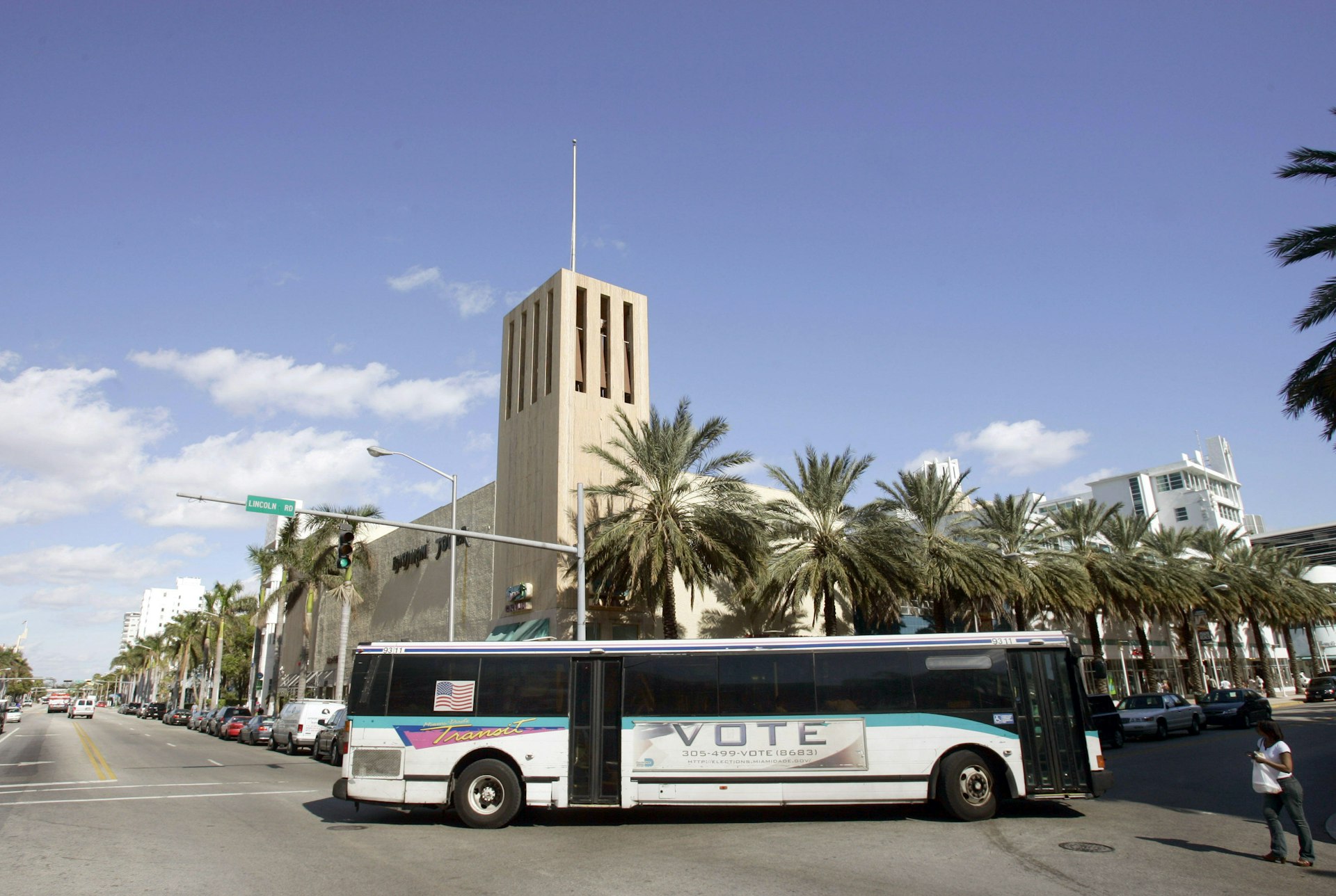
Exploring Maimi and the beach by bus
Miami’s local bus system is called Metrobus. It can get you most places you're trying to go, but it won't get you there very quickly. Each bus route has a different schedule and routes generally run from about 5:30am to 11pm, though some are 24 hours.
Rides cost $2.25 and must be paid in exact change (coins or a combination of bills and coins) or with an Easy Card (available for purchase from Metrorail stations and some shops and pharmacies). An easy-to-read route map is available online as a downloadable PDF.
Top tip for taking the bus in Miami: If you have to transfer buses, you'll have to pay the fare each time if paying in cash. With an Easy Card, transfers are free.

Taking the Miami trolley
The Trolley is actually a hybrid-electric bus service, using modern vehicles disguised as orange-and-green trolley buses, and it functions as a free bus service in Miami, Miami Beach, Coconut Grove, Little Havana and Coral Gables, among other locations. There are numerous routes, though they're made for getting around neighborhoods and not between them. The most useful for travelers are the following:
- Biscayne – travels along Biscayne Blvd; handy for transportation from Brickell to Downtown and up to the edge of Wynwood.
- Brickell – connects Brickell area (south of the Miami River in the Downtown area) with the Vizcaya Museum & Gardens.
- Coral Way – goes from Downtown (near the Freedom Tower) to downtown Coral Gables.
- Wynwood – zigzags through town, from the Adrienne Arsht Center for the Performing Arts up through Wynwood along NW 2nd Ave to 29th St.

Miami Beach trolleys
Miami Beach has four trolleys of its own running along different routes, with arrivals every 10 to 15 minutes from 6am to midnight (from 8am on Sundays).
- Alton-West Loop – runs up (north) Alton Rd and down (south) West Ave between 6th St and Lincoln Rd.
- Collins Link – runs along Collins Ave from 37th St to 73rd St. Catch it southbound from Abbott Ave and Indian Creek Dr.
- Middle Beach Loop – runs up Collins Ave and down Indian Creek Dr between 20th and 44th Sts (southbound it also zigzags over to Lincoln Rd).
- North Beach Loop – runs from 65th to 88th St.
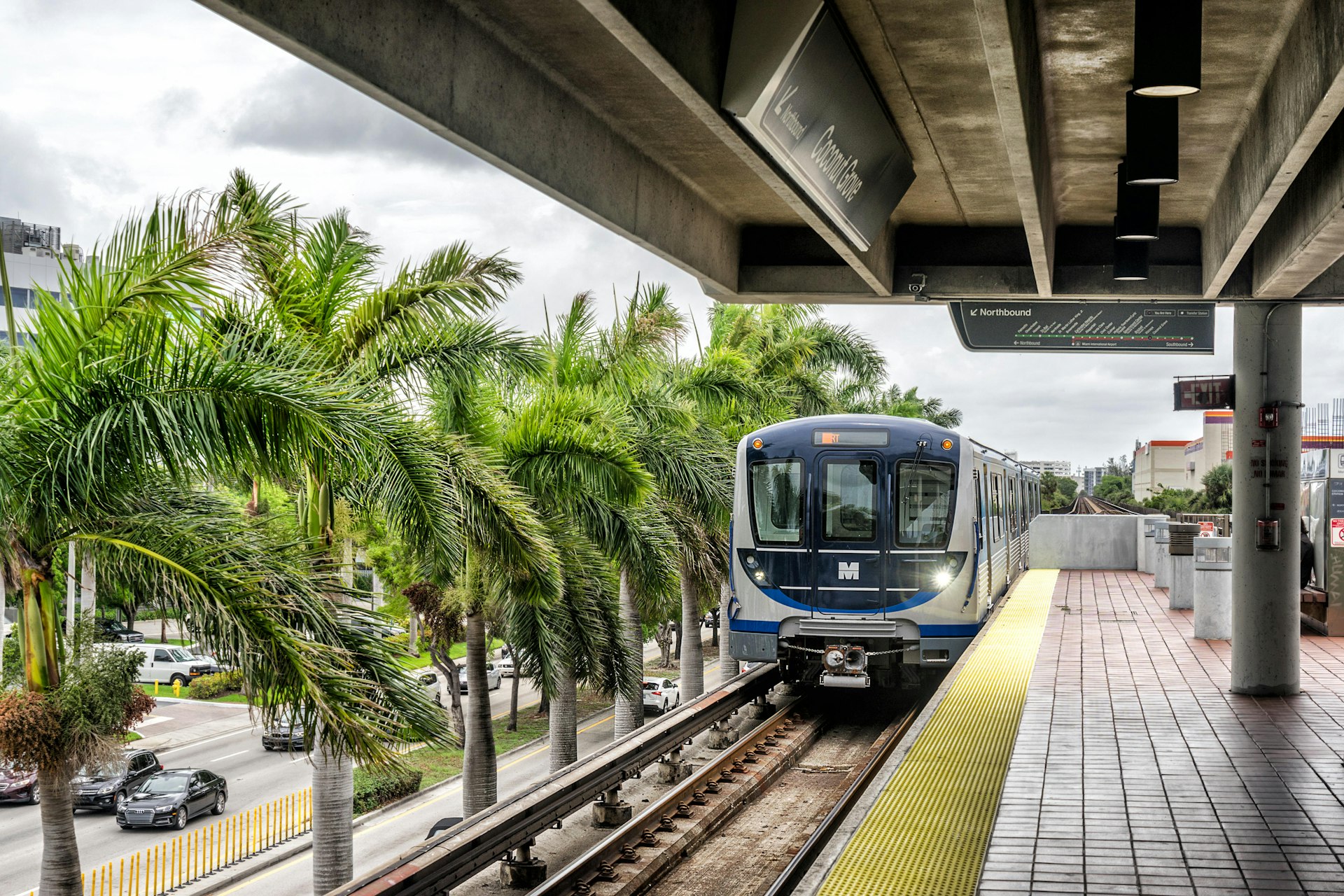
Tackling Miami by train
The Metromover, which is equal parts bus, monorail and train, is helpful for getting around Downtown Miami. It offers visitors a great perspective on the city and a free orientation tour of the area.
Metrorail is a 21-mile-long heavy-rail system that has one elevated line running from Hialeah through Downtown Miami and south to Kendall/Dadeland. Trains run every five to 15 minutes from 6am to midnight. The one-way fare is $2.25. Pay with either the reloadable Easy Card or a single-use Easy Ticket (these are sold from vending machines at Metrorail stations).
The regional Tri-Rail double-decker commuter trains run the 71 miles between Dade, Broward and Palm Beach counties, and they're handy for reaching the airport. Fares are calculated on a zone basis; the shortest distance traveled costs $4.40 round-trip; the most you’ll ever pay is for the ride between MIA and West Palm Beach ($11.55 round-trip).
Top tip for taking a train in Miami: No tickets are sold on the train, so allow time to make your purchase before boarding. All trains and stations are accessible to riders with disabilities. For a list of stations, log on to the Tri-Rail website.

Getting around by taxi and rideshare
Licensed taxis are easy to find all over Miami, run by various operators and clearly marked, but trip costs can mount up. Taxi fares are $2.95 for the first 1/6 of a mile, then $0.85 for each additional 1/6 of a mile up to a mile. It's then $0.40 each 1/6 of a mile thereafter. For a 20-minute trip (Lincoln Rd to Brickell City Center, for instance), the fare is upwards of $30.
Top tip for using rideshares in Miami: Given the high prices of taxis and the inconvenience of ordering them, most Miami residents use ride-sharing apps like Lyft and Uber.

Bicycles and scooters
Miami is flat, but traffic can be horrendous (abundant and fast-moving), and there isn't much of a biking culture (or respect for bikers) just yet. Nevertheless, bikes are a popular and easy way to cruise along the cycle paths tracing the beachfront.
Citi Bike is a bike-share program where you can borrow a bike from scores of kiosks spread around Miami and Miami Beach. Free paper maps of the bike network are available at some kiosks, or you can find one online. There's also a handy app that shows you where the nearest stations are. However, the clunky Citi Bikes are not ideal for longer trips (no helmet, no lock, and only three gears).
Top tip for riding in Miami: A variety of scooters are also available to rent via third-party apps such as Lyft throughout Miami Beach, Downtown, and Wynwood.
Walking in Miami
Miami is highly rated as a pedestrian-friendly city, but the reality in summer is that it's often just too darned hot. However, you'll probably find yourself promenading along the seafront on many occasions during your trip – amongst other things, it's the best way to admire the architecture of the Art Deco Historic District in Miami Beach. Districts such as Downtown can also be explored easily without a vehicle. Miami's many parks are also great places for a stroll before or after the hot part of the day.

Accessible travel in Miami
Most public buildings in Miami are wheelchair accessible and have appropriate restroom facilities. Transportation services are generally accessible to all, including busses and trains, and telephone companies provide relay operators for the hearing impaired. Many banks provide ATM instructions in Braille, curb ramps are common, and many busy intersections have audible crossing signals.
The city of Miami offers accommodations for travelers with disabilities on its beaches, in county parks, and other spaces run by the Recreation and Open Spaces Department. They advise calling ahead (305-755-7848) to reserve beach-friendly wheelchairs, which are typically first-come, first-serve. It's also advised to bring a friend, family member, or caretaker as the beach chairs are not self-propelled.
There are a number of organizations that specialize in the needs of disabled travelers, too. They include Miami & the Beaches, which offers accessible travel information specific to the Miami area. Mobility International USA advises disabled travelers on mobility issues and runs an educational exchange program. For more information, see Lonely Planet's Accessible Travel page.
You may also like:
Spend winter in Miami's best neighborhoods: sensual, glamorous and cultured
Winter sunshine: why now is the perfect time to visit Miami
Espresso yourself: 7 best spots to sip Cuban coffee in Miami
